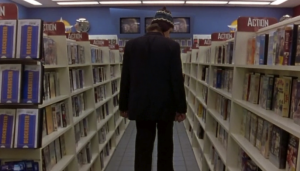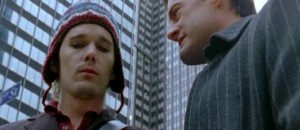From the Chicago Reader (May 19, 2000). — J.R.
It’s fitting that the most existential of plays should function as a kind of test, and fortunate that the first Michael Almereyda picture to get full mainstream exposure should also turn out to be his best to date. But what’s being tested isn’t either Shakespeare or Almereyda but the present moment: that is, the film asks how and how much we’re capable of living in the world Shakespeare wrote about. Wittily and tragically updating the play’s action to corporate America in general and New York in particular, Almereyda is no Orson Welles, but he begins to seem like one when he’s castigated for not doing his Shakespeare like Kenneth Branagh; the censure recalls all the times square and professional Laurence Olivier was used as a reproach to Welles’s hip “amateurism.” This is gloriously amateurish, the way all of Almereyda’s best movies are, so it’s rewarding to see how Julia Stiles’s Ophelia harks back to Suzy Amis in Almereyda’s Twister, how some of the intimate interiors recall Another Girl Another Planet (his second-best movie), and how the use of video as a kind of Greek chorus to the action, an Almereyda specialty, bears special fruit in a postmodernist climate where “To be or not to be” is recited in the action section of a Blockbuster and Hamlet (Ethan Hawke, better than you’d expect) lards his video production of The Mousetrap with all sorts of found footage. Fortunately, Almereyda has a terrific and game cast to score all his best points with: Bill Murray (Polonius), Kyle MacLachlan (Claudius), Diane Venora (Gertrude), Sam Shepard (the Ghost), and Liev Schreiber (Laertes), among others. And he employs a keen, labyrinthine sense of place to box, subdivide, and confound them. (Check out his great use of the Guggenheim, for instance.) Almereyda’s respect for his audience and his queasiness about the present register with equal weight, reinventing the poetry in the most relevant ways possible. Pipers Alley. — Jonathan Rosenbaum


